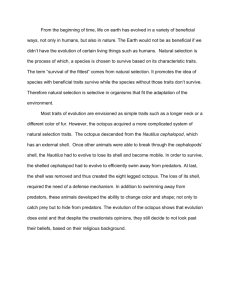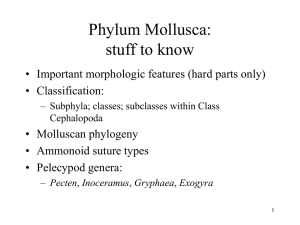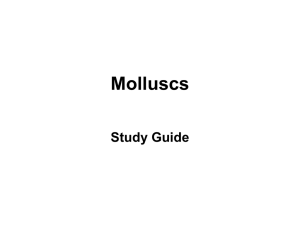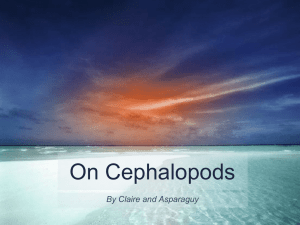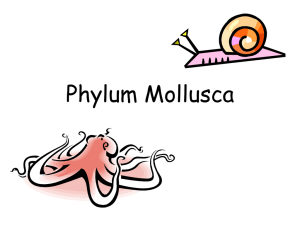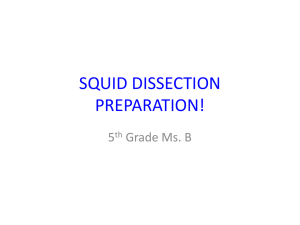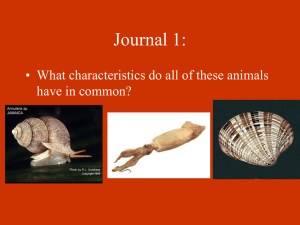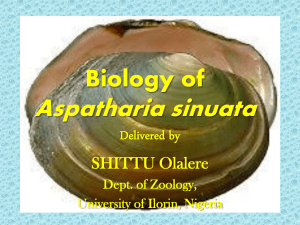Cephalopods_2013 2891KB Apr 28 2013 10:41:32
advertisement
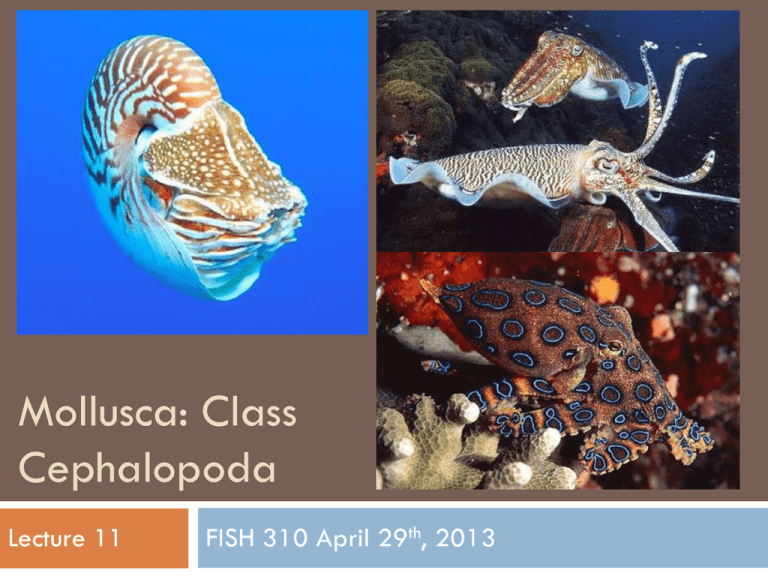
Mollusca: Class Cephalopoda Lecture 11 FISH 310 April 29th, 2013 Cephalophod Characteristics • Characteristics of class • • • • • • • All marine Most 6-70 cm up to 20m Architeuthis Shell divided by septa, chambers connected by siphuncle Closed circulatory system Foot modification Ganglia fused to form large brain in cartilaginous cranium ~700 species (~10K extinct) & 46 families Cephalopod Morphology Shell Tentacles Siphuncle Septa Radula Funnel Shell Gills Heart Cephalopod Morphology Mantle Arms Fins Extendable Tentacle Taxonomy • Nautiloidea • Coleoidea o Ammonoidea Cephalopod ecology • • • Strictly marine, none can tolerate freshwater Occupy most depths of ocean- from abyssal plain to sea surface All are predators and use tentacles to catch prey, beak to consume Cephalopod Shells • Nautilus possess a true external shell • • Shell spiral and divided by septa • • Hypostracum, Ostracum, Periostracum Animal in largest outermost chamber Septa penetrated by siphuncle • • Calcified tube Osmotic pump empty water from chambers, buoyancy http://www.fhperry.com/pages/relationships.html Shells and Buoyancy Regulation • Nautilus: chambered shell • • • • Gas diffusion into gap between mantle and shell Cuttlefish: internal chambered shell involved in buoyancy regulation Squid: internalized shell=pen Regulate water volume Movement • Jet propulsion • • • • Nautilus: Expel water from mantle cavity through funnel Other cephalopods: contract and expand mantle tissue Escaping predators and capturing prey Arms (Octopus) or muscular lateral fins (squid and cuttlefish) Jet Propulsion • • • • • Water enter cavity through one-way valves Influx cause animal to draw forward Muscles relax, large volume of water expelled Enable cephalopod to move at high speed Circular and radial muscles Jet Propulsion • Circular and radial muscles • • Contraction of circular muscles expels water Contractions of radial muscle hyperextends mantle cavity Cephalopod protection • Chromatophores • • • • Tiny colored cells or pigment sacs that overlay reflective cells (iridocytes) Muscle contraction=sac expansion Defensive, camouflaging, and courtship behaviors Red, yellow, black and brown Cephalopod protection • Iridophores • • Brain reads changing light passing through eye, trigger electrical instructions Appear as shifting iridescent colors depending on the angle of light Cephalopod protection • Iridophores • • • • • Pigment cells that diffract light using plates of crystalline chemochromes When illuminated, generate iridescent colors from reflecting light within stacked plates Light hits plates, some reflected and some passes through Can match wavelength of different colors of light by controlling size of gap between plates Metallic greens and blues Cephalopod protection • Photophores- light production by biochemical reactions • • • Bioluminescence: biochemical production of light with minimal heat Produced by symbiotic bacteria living within photophores Attracting/recognizing mates, luring in prey, and protecting against predation Cephalopod protection • Ink Sac • • • • Most cephalopods other than Nautilus Dark-pigmented fluid=melanin and mucous Form a cloud that confuses potential predators May act as mild narcotic Cephalopod protection • Ink Sac • • • Pseuodomorph decoy Greater mucus content Resemblance to cephalopod that released it Nervous System • • • • • Highly developed- correlated with locomotor dexterity Cephalization encased in cartilaginous cranium Large complex highly differentiated brain Nerves from visceral ganglia supply the mantle Command center: pair of very large neurons, fired by impulses from sensory organs Squid giant axon: providing clues to nerve cell repair • • • • Giant axon up to 1mm in diameter Model for nerve cell repair Inject membrane with fluorescent dyes visualize what occurs when nerve injured Axon membrane diameter shrinks and vesicles travel to site of injury Feeding Mechanisms • • Raptorial feeding and carnivorous diet Tentacles with adhesive suckers • • • • Rim is toothed and inner wall has hooks Radula Pair of powerful beak-like jaws Two pairs of salivary glands • • Anterior=mucous Posterior=poison, proteolytic enzymes (Octopus) Digestive System • • • • Complete digestive system with food transport via peristalsis Digestive glands or digestive caeca Digestion is extracellular Absorption • • • Cecal walls=thin (Loligo) Digestive gland=thick (Sepia and Octopus) Waste through anus Cephalopod Reproduction • • • No known hermaphrodites Usually dioecious: gonads in posterior of body Internal fertilization • One arm of male modified as a copulatory organ to transfer sperm (hectocotylus) Paper Nautilus: Argonauta • • • Pelagic octopus Adaptation for egg deposition Eggcase secreted by tips of two expanded dorsal arms of female • • • Deposit eggs directly into case Shell act as a brood chamber and a retreat for the female Eggcase contains bubble of air used for buoyancy Blue-ringed octopus • • • • Genus Hapalochlaena Tide pools and coral reefs in Indian and Pacific Oceans Use chromatophores to camouflage, changes color when provoked One of the world’s most venomous animals, powerful enough to kill humans with no antivenom • • • Neurotoxin 100x more powerful than cyanide Blocks sodium channels, causing motor paralysis and respiratory arrest Produced by bacteria in salivary glands Vampire squid Vampyroteuthis infernalis • • Deep sea in temperate and tropical areas Radical adaptations to life in deep sea • • • • Lowest mass-specific metabolic rate Sophisticated statocysts Ammonium-rich tissues No ink sac, • • Bioluminescent mucus as defense system Turn inside-out The Giant Squid: Architeuthis dux • • • • Elusive creature Eyes among the largest in the world- adaptation Tentacles with suction cups with rings of chitin Highly complex nervous system and highly developed brain Humboldt squid migration • • Squids moving north in response to overfishing and climate change Ocean acidification changing their metabolism, driving them to shallower water Awesome Videos! • • • Octopus camouflage: http://www.youtube.com/watch?v=PmDTtkZlMwM Cuttlefish camouflage: http://www.youtube.com/watch?v=__XA6B41SQQ Vampire squid: http://www.youtube.com/watch?v=IWAnliNc6wk
